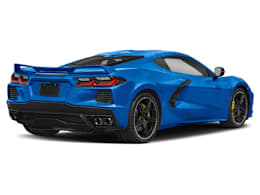It was with great anticipation that we tested the completely redesigned Corvette Stingray, with its new rear/mid-engine layout—a configuration long favored by Ferrari, Lamborghini, and other exotic sports-car companies.
We came away from the experience impressed by the C8 Corvette’s performance numbers and thrilled with its fun-to-drive nature.
Showcased under the glass rear hatch sits a 6.2-liter V8. There aren’t any turbochargers or hybrid electric-assist here, just 495 unadulterated, naturally-aspirated horsepower coupled with an eight-speed dual-clutch automatic transmission that clicks off shifts in rapid-fire manner. Sadly, a manual transmission is no longer an option, but drivers can still shift the ‘Vette themselves by using the paddles behind the steering wheel.
Regardless, the thunderous engine sounds glorious when pushed hard. We clocked the Corvette at 3.4 seconds from 0 to 60 mph, making it among the quickest cars we’ve ever tested. The 19 mpg overall on premium fuel the Corvette managed in our testing doesn’t break new ground in terms of efficient sports cars, but it’s not all that surprising given the level of performance on tap here.
Handling agility is superb, thanks to immediate turn-in response from the near-telepathic steering and barely a trace of body roll through corners. This is a car that deserves to be driven on a track to fully experience its astonishing levels of grip and powerful, secure braking ability. As we found out on the road-course track at the CR Auto Test Center, the Corvette is a sheer delight when driven near its limits, attacking corners with verve and gobbling up straightaways as if it hasn’t eaten in days. And although the Corvette has extremely high capabilities thanks to its mid-engine weight distribution, taut suspension, and sticky tires, we found it quite controllable at its limits, and it shouldn’t scare off less skilled drivers.
Even with its otherworldly performance, the ride from the optional adaptive suspension system is civilized in the Tour setting. In that softer setting, the Corvette provides a docile driving experience that isn't punishing, cushioning bumps better than most hardcore sports cars. Switching the car to its Sport or Track modes stiffens up the suspension, and gives the exhaust a sharper note that your neighbors would likely appreciate you reserve for your favorite mountain road.
Opinions were mixed when it came to the optional, racy-looking GT2 seats in our tested Corvette 2LT trim. The large, power-adjustable side bolsters hold you in place through corners with tenacity, but they proved too narrow and restrictive, even when moved to their widest setting, for some drivers. If these seats fit you, the firm cushions are comfortable; if they don’t, the constrictive character will likely get annoying on longer drives.
The Corvette comes standard with a removable targa-top roof panel that can be stowed conveniently in the rear trunk aft of the engine. Once you understand how the roof panel gets secured in the trunk (the instructions in the owner’s manual are a bit confusing), it’s an easy process for two people, and not that difficult to perform solo, as well. The roof panel doesn’t leave much room left over for cargo in the trunk, though, and the front trunk (or “frunk”) is pretty small.
As with other sports cars, there are compromises. The Corvette is so low to the ground that getting in and out could count as your daily yoga routine. Side and rear visibility are practically nonexistent, due to thick side pillars and a tiny rear window. And the long line of climate-control buttons perched on a ledge in between the driver and passenger are difficult to use, especially when driving.
It is great to see that for the 2024 model year, forward collision warning (FCW) and automatic emergency braking (AEB) with pedestrian detection, and lane keeping assistance and lane departure warning are standard. Blind spot warning (BSW) and rear cross traffic warning (RCTW) are optional.
Also new for the 2024 model year was the first-ever hybrid Corvette, called the E-Ray. But unlike most hybrids, the E-Ray isn’t designed to save you money at the pump. An electric motor at the front axle (which gives it all-wheel drive—also a first for the Corvette) supplements the regular Stingray’s 6.2-liter V8 situated behind the driver for a total combined output of 655 horsepower and a neck-snapping, Chevrolet-claimed 2.5-second 0 to 60 mph time. Of course, this performance comes at a cost – a steep nearly $40,000 price premium over the base Stingray.
Although we didn’t purchase one for our official test program, we had the opportunity to spend some time with a rented E-Ray from Chevrolet. Overall, our testers were impressed with the abundantly powerful, crisp-shifting hybrid powertrain and responsive handling. But perhaps the most pleasant surprise was the E-Ray’s comfort and livability; this revelation was especially keen considering its over-the-top performance specs. GM told us that they view the E-Ray as a “Grand Touring” Corvette, a statement validated by multiple drive modes that can adjust suspension damping and steering response from a more comfortable “Tour” mode, to a more tied-down and livelier “Track” mode. Even the glorious sound of the V8 engine can be completely hushed with a feature called “Stealth Mode”. Stealth Mode allows the E-Ray to drive a few miles at speeds up to 45 mph using only the front electric motor – just enough for you to escape crowded suburbia early in the morning without waking the neighbors. But alas, as soon as the air conditioning is turned on, the Stealth mode is canceled. Overall, the E-Ray delivers supercar thrills and proves to be a worthy example of an electrified performance vehicle.


























